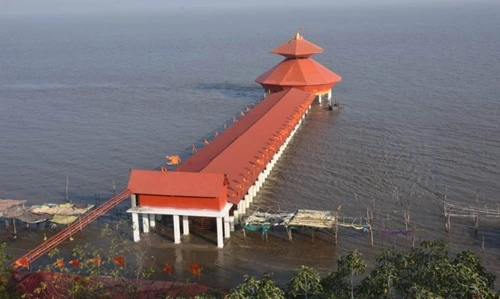Kavi Kamboi Temple, also known as Stambheshwar Mahadev Temple, is one of Gujarat’s hidden spiritual gems. Located in the coastal village of Kavi Kamboi, near the Gulf of Cambay, this unique temple is dedicated to Lord Shiva and stands right on the shore, making it a stunning and mystical destination. What makes Kavi Kamboi Temple so remarkable is its tidal nature—the temple is submerged during high tide and reappears as the tide recedes, creating an extraordinary sight that draws pilgrims, nature lovers, and curious travelers alike.
Choosing the best time to visit Kavi Kamboi Temple is essential, as witnessing this phenomenon of the disappearing and reappearing temple adds a mystical quality to the visit. From the cool and pleasant winter months to the monsoon season’s lush surroundings, each season offers a unique experience. Here’s a guide to planning your trip to the Kavi Kamboi Temple to make the most of your journey.

Best Seasons to Visit Kavi Kamboi Temple
1. Winter (November to February)
Winter is considered the best time to visit Kavi Kamboi Temple, as the weather is cool and pleasant, with temperatures ranging from 12°C to 25°C. The comfortable weather allows visitors to explore the temple and its surroundings without the discomfort of intense heat. The low tides during this period also make it easier to time your visit to catch the temple’s magical appearance and disappearance.
Mornings in winter offer a peaceful and serene atmosphere, allowing you to experience the temple’s beauty at its best. The coastal breeze and mild weather make it ideal for a relaxed visit, where you can explore the temple grounds, take photographs, and participate in the rituals without being rushed. Sunset during winter months provides a beautiful view as the golden light reflects on the waters, creating a mystical setting.
Winter also draws a larger number of devotees and visitors, adding a vibrant energy to the temple. This season is particularly special as many travelers and pilgrims arrive during Makar Sankranti (mid-January), a festival celebrated in Gujarat with great enthusiasm, including special prayers and gatherings at temples like Kavi Kamboi.
2. Monsoon (July to September)
Monsoon brings a refreshing charm to Kavi Kamboi Temple, with lush greenery around the coast and a dynamic play of rain and tides. Temperatures during the monsoon range from 22°C to 30°C, and while rain showers are frequent, they add to the scenic beauty of the location. Visiting Kavi Kamboi Temple during the monsoon season offers a unique experience as the tides become more dramatic, creating a spectacular view of the temple as it submerges and reemerges.
During this season, the surrounding landscape is vibrant, and the air feels crisp and fresh. The monsoon clouds and gentle rain showers create an enchanting atmosphere, making it ideal for photography and for those who appreciate nature’s beauty. However, it’s essential to be cautious when visiting during monsoon, as slippery surfaces and unpredictable weather may require careful navigation. Waterproof clothing and footwear are recommended, as the rains can intensify quickly.
Monsoon is also a quieter time, with fewer crowds compared to the peak winter season. This allows for a more peaceful experience, ideal for introspection and connecting with the spiritual aura of the temple.
3. Summer (March to June)
Summer in Kavi Kamboi can be quite hot, with temperatures often reaching 40°C in the peak months of May and June. However, early summer (March and April) still offers bearable weather, with temperatures ranging from 25°C to 35°C. If you plan to visit during this period, it’s best to schedule your visit for early mornings or late afternoons to avoid the heat.
Despite the warmth, summer has its own charm at Kavi Kamboi Temple. The tide cycle remains active, allowing visitors to witness the temple’s submersion and reappearance against a clear sky. Fewer tourists visit during summer, so those who prefer a quieter experience will find it a peaceful time to explore. Watching the tide roll in and out against a backdrop of vivid blue skies creates a stunning contrast and adds to the temple’s mystical appeal.
If you choose to visit in summer, carry plenty of water, sun protection, and wear light, breathable clothing to stay comfortable. The coastal breeze offers some relief, but visitors should still be prepared for the heat.
Key Attractions and Activities at Kavi Kamboi Temple
- Witnessing the Tidal Phenomenon: The most captivating aspect of Kavi Kamboi Temple is its submersion during high tide and reappearance as the tide recedes. Check the local tide timings in advance to ensure you experience this unique natural event.
- Rituals and Prayers: As a sacred site dedicated to Lord Shiva, the temple hosts various rituals and prayers, particularly on Mondays and during special Hindu festivals. Visitors can participate in the prayers and seek blessings from Lord Shiva.
- Photography: Kavi Kamboi Temple offers an excellent setting for photography. Capturing the temple as it stands against the sea or while submerged during high tide can result in dramatic and memorable photos. The surrounding coastal landscape also provides a beautiful backdrop for scenic shots.
- Exploring the Coastline: The temple’s coastal location makes it an ideal spot for a leisurely walk along the shore. The quiet coastline allows for peaceful exploration and is perfect for unwinding while taking in the sea breeze and scenic surroundings.
- Local Culture and Cuisine: Kavi Kamboi is a small village with a charming, authentic vibe. Visitors can explore local shops and eateries, tasting traditional Gujarati snacks and sweets like fafda, jalebi, and khaman. Engaging with the locals adds depth to the experience and offers insights into the area’s traditions.
Practical Tips for Visiting Kavi Kamboi Temple
- Check Tide Timings: The key to experiencing the temple’s disappearing and reappearing act is knowing the local tide timings. Plan your visit around low tide to access the temple and high tide to witness its submersion.
- Best Time of Day: Visiting during early morning or late afternoon offers cooler temperatures and softer lighting, especially in summer. Sunrise and sunset provide beautiful views, enhancing the mystical ambiance of the temple.
- Clothing and Footwear: Comfortable, non-slippery footwear is recommended, especially during monsoon when the terrain can become slippery. Light clothing is ideal for summer, while warm attire is suggested for winter evenings.
- Respect Local Customs: As a religious site, visitors are encouraged to respect the temple’s sanctity and follow local customs, such as removing footwear before entering and dressing modestly.
- Nearby Attractions: If you have extra time, consider exploring nearby destinations like the Shuklatirth Mahadev Temple, which is also along the coast, or the historic city of Vadodara, which offers additional sightseeing and cultural experiences.
Conclusion
Kavi Kamboi Temple, with its awe-inspiring tidal phenomenon and serene coastal beauty, offers an experience unlike any other in Gujarat. From the cool, bustling winters to the lush and peaceful monsoons, each season brings a distinct flavor to this sacred site. By planning your visit around the tide cycle and choosing a season that aligns with your preferences, you can fully immerse yourself in the spiritual and natural beauty of Kavi Kamboi Temple. Witness the mystical ebb and flow of this unique Shiva temple and let the tranquility of the shoreline leave you with lasting memories of Gujarat’s coastal charm.


